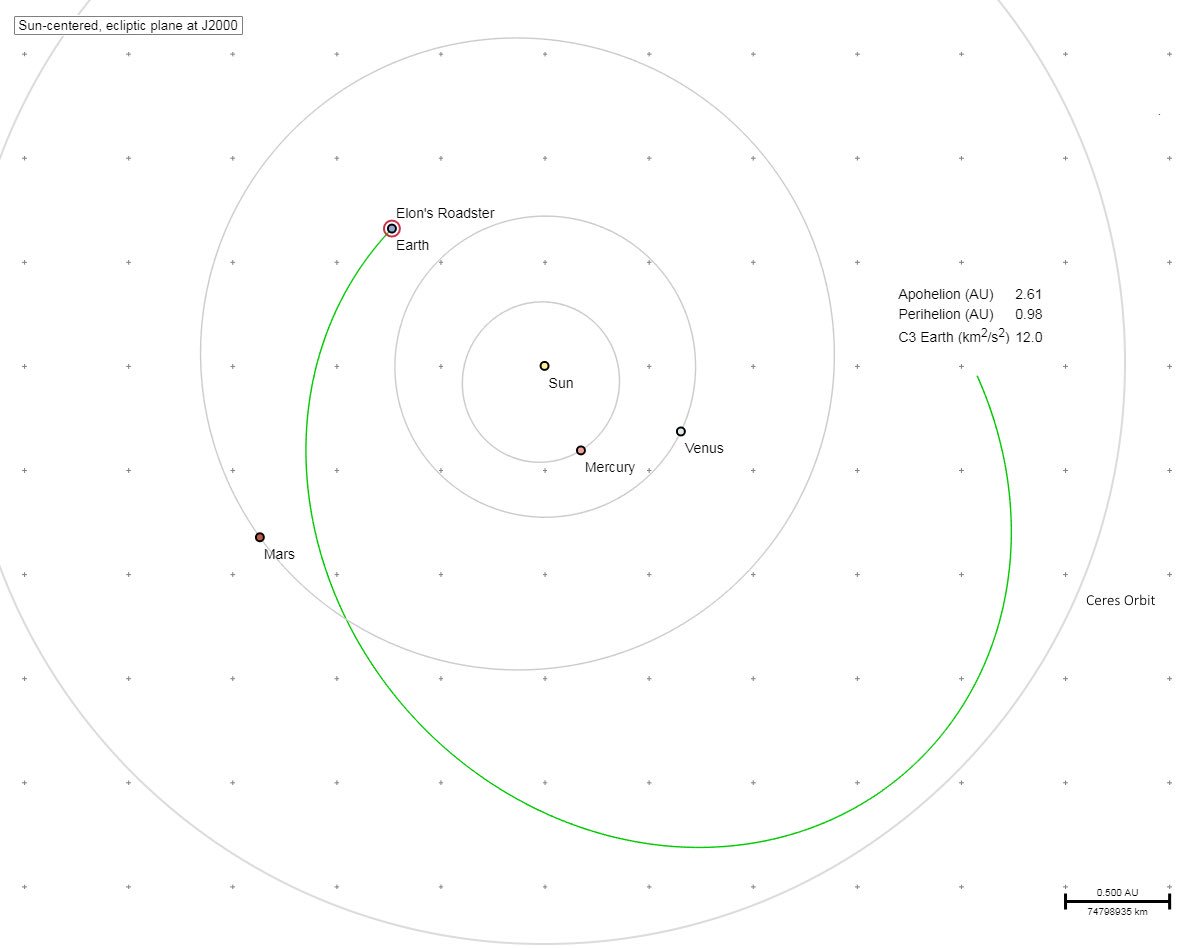Elon Musk's Tesla Roadster Is Headed to the Asteroid Belt
A red car for a Red Planet. That's what Elon Musk was hoping for when he launched his own Tesla Roadster on SpaceX's first Falcon Heavy rocket Tuesday (Feb. 6), headed for an orbit that might have extended out to the orbit of Mars. But his car, it turns out, is taking a detour through the asteroid belt.
Musk's Roadster and its mannequin "driver," dubbed "Starman," launched into space from NASA's Kennedy Space Center in Cape Canaveral, Florida, as a "mass simulator" aboard SpaceX's Falcon Heavy test flight. The launch was a huge success, Musk said, leaving only the fate of SpaceX's Starman and the Roadster up in the air.
Would the car and mannequin, attached to the Falcon Heavy's second stage, survive an experimental 6-hour coast phase that would send it through Earth's radiation-flooded Van Allen belts? And would an engine burn by the second stage after that coast go as planned, sending the Roadster out to the orbit of Mars? [In Photos: SpaceX's 1st Falcon Heavy Rocket Test Launch Success!]

In a late-night update, Musk announced that the Falcon Heavy stage did survive its daring slog through the Van Allen belts.
"Third burn successful," Musk wrote on Twitter. "Exceeded Mars orbit and kept going to the Asteroid Belt."
Starman and the Roadster are now flying in a long, elliptical orbit around the sun. At its farthest point, that orbit extends nearly 243 million miles (390 million kilometers). That's 2.61 times the average distance between Earth and the sun, which is, on average, about 93 million miles (150 million km).
For reference, Mars orbits the sun at an average distance of 142 million miles (228 million km). At their closest point to the sun, Starman and the Roadster will fly just inside Earth's orbit, according to the diagram.
Get the Space.com Newsletter
Breaking space news, the latest updates on rocket launches, skywatching events and more!
So, yeah. That's one epic trip.
At a news conference after Tuesday's Falcon Heavy launch, Musk said the Roadster will orbit the sun for millions, perhaps even billions, of years.
He wondered what aliens might think if they ever came across the Roadster drifting through space. After all, SpaceX packed other weird items in the car, among them a small toy Hot Wheels Roadster (complete with a miniature Starman) on the dashboard.
"Maybe [it will be] discovered by an alien race, thinking, 'What were these guys doing? Did they worship this car? Why do they have a little car in the car?'" Musk said. "That will really confuse them."
Email Tariq Malik at tmalik@space.com or follow him @tariqjmalik and Google+. Follow us @Spacedotcom, Facebook and Google+. Original article on Space.com.
Join our Space Forums to keep talking space on the latest missions, night sky and more! And if you have a news tip, correction or comment, let us know at: community@space.com.

Tariq is the Editor-in-Chief of Space.com and joined the team in 2001, first as an intern and staff writer, and later as an editor. He covers human spaceflight, exploration and space science, as well as skywatching and entertainment. He became Space.com's Managing Editor in 2009 and Editor-in-Chief in 2019. Before joining Space.com, Tariq was a staff reporter for The Los Angeles Times covering education and city beats in La Habra, Fullerton and Huntington Beach. In October 2022, Tariq received the Harry Kolcum Award for excellence in space reporting from the National Space Club Florida Committee. He is also an Eagle Scout (yes, he has the Space Exploration merit badge) and went to Space Camp four times as a kid and a fifth time as an adult. He has journalism degrees from the University of Southern California and New York University. You can find Tariq at Space.com and as the co-host to the This Week In Space podcast with space historian Rod Pyle on the TWiT network. To see his latest project, you can follow Tariq on Twitter @tariqjmalik.









